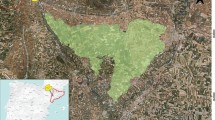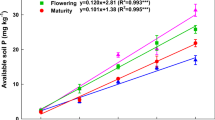Abstract
Failures of tailings dams have degraded large areas of agricultural alluvial soils worldwide, and concomitant soil pollution studies are abundant. Yet, the data on the actual effects of thereby imposed stresses on major crops are scarce. This work analyses the effect of pyrite tailings from a copper mine, deposited over crop fields by long-term flooding, on wheat (Triticum aestivum L.) under field conditions. The major previously reported polluting agents were Cu, As, Zn, Pb and acidity generated by sulphide oxidation. Flexible systematic sampling, based on visual symptoms in wheat, included transects through partially damaged fields (from calcareous to acid soils). Multivariate analysis of soil properties, leaf mineral composition and growth parameters revealed a consistent underlying soil gradient of decreasing available P and increasing Stot. Phosphorus was shown to have the highest unique contribution to predicting wheat yield, consistent correlation with growth and visual symptoms, and concentrations in the range of severe deficiency. In P deficient plants N deficiency, decrease of available micronutrients and increase of As occur irrespectively of their soil concentrations, and the competition with superior “pyrite” weeds increases. Different sorption of P and possible rhizotoxic effects of other pollutants imply that fertilization can hardly be a solution.







Similar content being viewed by others
References
Adalsteinsson S (1994) Compensatory root growth in winter wheat: effects of copper exposure on root geometry and nutrient distribution. J Plant Nutr 17:1501–1512
Adriano D, Chlopecka A, Kaplan D, Clijsters H, Vangronsveld J (1997) Soil contamination and remediation: philosophy, science and technology. In: Prost R (ed) Contaminated soils, Proceedings of the International Conference on the Biogeochemistry of Trace Elements, 15–19 May 1995, Paris, France. INRA, Paris, pp 465–504
Allen SE (1974) Chemical analysis of ecological materials. Blackwell, Oxford
Álvarez-Ayuso E, García-Sánchez A, Querol X, Moyano A (2008) Trace element mobility in soils seven years after the Aznalcóllar mine spill. Chemosphere 73:1240–1246
Antonovic G (1974) Zemljišta basena Timoka. Centar za Poljoprivredna Istraživanja, Beograd
Barrow NJ, Mendoza RE (1990) Equations for describing sigmoid yield responses and their application to some phosphate responses by lupins and by subterranean clover. Nutr Cycl Agroecosys 22:181–188
Bergmann W (1992) Nutritional disorders of plants: development, visual and analytical diagnosis. Gustav Fischer, Jena
Bergmann W, Neubert P (1976) Pflanzendiagnose und Pflanzenanalyse zur Ermittlung von Ernahrungsstorungen und des Ernahrungszustandes der Kulturpflanzen. Gustav Fischer, Jena
Bhadoria P, Steingrobe B, Claassen N, Liebersbach H (2002) Phosphorus efficiency of wheat and sugar beet seedlings grown in soils with mainly calcium, or iron and aluminium phosphate. Plant Soil 246:41–52
Bird G, Brewer P, Macklin M, Balteanu D, Serban M, Driga B, Zaharia S (2008) River system recovery following the Novat-Rosu tailings dam failure, Maramures County, Romania. Appl Geochem 23:3498–3518
Bollons H, Barraclough P (1999) Assessing the phosphorus status of winter wheat crops: inorganic orthophosphate in whole shoots. J Agr Sci 133:285–295
Bradshaw A (1997) Restoration of mined lands—using natural processes. Ecol Eng 8:255–269
Bray E, Bailey-Serres J, Weretilnyk E (2000) Responses to abiotic stresses. In: Gruissem W, Buchannan B, Jones R (eds) Biochemistry and molecular biology of plants. American Society of Plant Physiologists, Rockville, pp 1158–1249
Bray R, Kurtz LT (1945) Determination of total, organic, and available forms of phosphorus in soils. Soil Sci 59:39–46
Brennan RF (1988) Effect of phosphorus deficiency in wheat on the infection of roots by Gaeumannomyces graminis var. tritici. Aust J Agric Res 39:541–546
Burgos P, Madejón E, Pérez de Mora A, Cabrera F (2006) Spatial variability of the chemical characteristics of a trace-element-contaminated soil before and after remediation. Geoderma 130:157–175
Chen J, Chen JZ, Tan MZ, Gong ZT (2002) Soil degradation: a global problem endangering sustainable development. J Geog Sci 12:243–252
Clemente R, Walker D, Bernal M (2005) Uptake of heavy metals and As by Brassica juncea grown in a contaminated soil in Azñalcóllar (Spain): the effect of soil amendments. Environ Pollut 138:46–58
de Groot C, Marcelis L, van den Boogaard R, Kaiser W, Lambers H (2003) Interaction of nitrogen and phosphorus nutrition in determining growth. Plant Soil 248:257–268
Del Rio M, Font R, Almela C, Velez D, Montoro R, De Haro BA (2002) Heavy metals and arsenic uptake by wild vegetation in the Guadiamar river area after the toxic spill of the Azñalcóllar mine. J Biotechnol 98:125–137
Domínguez M, Marañón T, Murillo JM, Schulin R, Robinson B (2008) Trace element accumulation in woody plants of the Guadiamar Valley, SW Spain: a large-scale phytomanagement case study. Environ Pollut 152:50–59
Domínguez M, Marañón T, Murillo JM, Schulin R, Robinson B (2010) Nutritional status of mediterranean trees growing in a contaminated and remediated area. Water Air Soil Poll 205:305–321
Egner H, Riehm H, Domingo WR (1960) Untersuchungen über die chemische Bodenanalyse als Grundlage für die Beurteilung des Nährstoffzustandes der Böden. II. Chemische Extraktionsmethoden zur Phosphor und Kalium-bestimmung. K. Lantbrukshoegsk. Ann 26:199–215
Elliott D, Reuter DJ, Reddy GD, Abbott R (1997a) Phosphorus nutrition of spring wheat (Triticum aestivum L.). 1. Effects of phosphorus supply on plant symptoms, yield, components of yield, and plant phosphorus uptake. Aust J Agric Res 48:855–868
Elliott D, Reuter DJ, Reddy GD, Abbott R (1997b) Phosphorus nutrition of spring wheat (Triticum aestivum L.). 3. Effects of plant nitrogen status and genotype on the calibration of plant tests for diagnosing phosphorus deficiency. Aust J Agric Res 48:883–898
Gallart F, Benito G, Martín-Vide J, Benito A, Prió J, Regüés D (1999) Fluvial geomorphology and hydrology in the dispersal and fate of pyrite mud particles released by the Azñalcóllar mine tailings spill. Sci Total Environ 242:13–26
Hüttl RH, Weber E (2001) Forest ecosystem development in post-mining landscapes: a case study of the Lusatian lignite district. Naturwissenschaften 88:322–329
Knowles F, Watkin JE (1931) The assimilation and translocation of plant nutrients in wheat during growth. J Agri Sci 21:612–637
López-Pamo E, Barettino D, Antón-Pacheco C, Ortiz G, Arránz J, Gumiel J, Martínez-Pledel B, Aparicio M, Montouto O (1999) The extent of the Aznalcοllar pyritic sludge spill and its effects on soils. Sci Total Environ 242:57–88
Macklin MG, Brewer PA, Hudson-Edwards KA, Bird G, Coulthard TJ, Dennis IA, Lechler PJ, Miller JR, Turner JN (2006) A geomorphological approach to the management of rivers contaminated by metal mining. Geomorphology 79:423–447
Madejón P, Marañón T, Murillo JM, Robinson B (2004) White poplar (Populus alba) as a biomonitor of trace elements in contaminated riparian forests. Environ Pollut 132:145–155
Madejón P, Murillo JM, Marañón T, Cabrera F, Lopez R (2002) Bioaccumulation of As, Cd, Cu, Fe and Pb in wild grasses affected by the Azñalcóllar mine spill (SW Spain). Sci Total Environ 290:105–120
Madejón P, Murillo JM, Marañón T, Cabrera F, Soriano M (2003) Trace element and nutrient accumulation in sunflower plants two years after the Azñalcóllar mine spill. Sci Total Environ 307:239–257
Madejón P, Murillo JM, Marañón T, Lepp NW (2007) Factors affecting accumulation of thallium and other trace elements in two wild Brassicaceae spontaneously growing on soils contaminated by tailings dam waste. Chemosphere 67:20–28
Marschner H (1995) Mineral nutrition of higher plants. Academic, London
Meharg AA, Hartley-Whitaker J (2002) Arsenic uptake and metabolism in arsenic resistant and nonresistant plant species. New Phytol 154:29–43
Mortvedt JJ, Cox FR, Shuman LM, Welch RM (1991) Micronutrients in agriculture. SSSA, Madison
Murillo JM, Marañón T, Cabrera F, López R (1999) Accumulation of heavy metals in sunflower and sorghum plants affected by the Guadiamar spill. Sci Total Environ 242:281–292
Naidu R, Smith E, Owens G, Bhattacharya P, Nadebaum P (2006) Managing arsenic in the environment—from soil to human. CSIRO, Melbourne
Néel C, Bril H, Courtin-Nomade A, Dutreuil JP (2003) Factors affecting natural development of soil on 35-year-old sulphide-rich mine tailings. Geoderma 111:1–20
Pearse S, Veneklaas E, Cawthray G, Bolland M, Lambers H (2007) Carboxylate composition of root exudates does not relate consistently to a crop species’ ability to use phosphorus from aluminium, iron or calcium phosphate sources. New Phytol 173:181–190
Pigna M, Cozzolino V, Violante A, Meharg A (2009) Influence of phosphate on the arsenic uptake by wheat (Triticum durum L.) irrigated with arsenic solutions at three different concentrations. Water Air Soil Poll 197:372–380
Rerkasem B, Jamjod S (2004) Boron deficiency in wheat: a review. Field Crop Res 89:173–186
Rose T, Hardiputra B, Rengel Z (2010) Wheat, canola and grain legume access to soil phosphorus fractions differs in soils with contrasting phosphorus dynamics. Plant Soil 326:159–170
Sah R, Mikkelsen D (1986) Transformations of inorganic phosphorus during the flooding and draining cycles of soil. Soil Sci Soc Am J 50:62–67
Smartt P (1978) Sampling for vegetation survey: a flexible systematic model for sample location. J Biogeogr 5:43–56
Thompson J, Proctor J (1983) Vegetation and soil factors on a heavy metal mine spoil heap. New Phytol 94:297–308
Vrbnicanin S, Kojic M (2002) Weed vegetation in small grains crops in lowland and mountainous areas of Central Serbia and its syntaxonomic status. Acta Herbol 11:33–42
Walker DJ, Clemente R, Bernal M (2004) Contrasting effects of manure and compost on soil pH, heavy metal availability and growth of Chenopodium album L. in a soil contaminated by pyritic mine waste. Chemosphere 57:215–224
Wang L, Duan G (2009) Effect of external and internal phosphate status on arsenic toxicity and accumulation in rice seedlings. J Environ Sci 21:346–351
Wang W, Vinocur B, Altman A (2003) Plant responses to drought, salinity and extreme temperatures: towards genetic engineering for stress tolerance. Planta 218:1–14
Weiss D, Carbiener R, Trémollères M (1991) Biodisponibilité comparée du phosphore en fonction des substrats et de la fréquence des inondations dans trois forêts alluviales rhénanes de la plaine d’Alsace. Cr Acad Sci III-Vie 313:245–251
Wiegleb G, Felinks B (2001) Primary succession in post-mining landscapes of Lower Lusatia—chance or necessity. Ecol Eng 17:199–217
Wolkersdorfer C, Bowel R (2005) Contemporary reviews of mine water studies in Europe: part 2. Mine Water Environ 24:2–37
Acknowledgement
This work is dedicated to the memory of Miodrag Jakovljević, professor of the Belgrade University. The research was supported by the Serbian Ministry of Science and Technology (grant no. 153002). We thank Ernest A. Kirkby (University of Leeds, UK) for improving the English.
Author information
Authors and Affiliations
Corresponding author
Additional information
Responsible Editor: Henk Schat.
Rights and permissions
About this article
Cite this article
Nikolic, N., Kostic, L., Djordjevic, A. et al. Phosphorus deficiency is the major limiting factor for wheat on alluvium polluted by the copper mine pyrite tailings: a black box approach. Plant Soil 339, 485–498 (2011). https://doi.org/10.1007/s11104-010-0605-x
Received:
Accepted:
Published:
Issue Date:
DOI: https://doi.org/10.1007/s11104-010-0605-x




